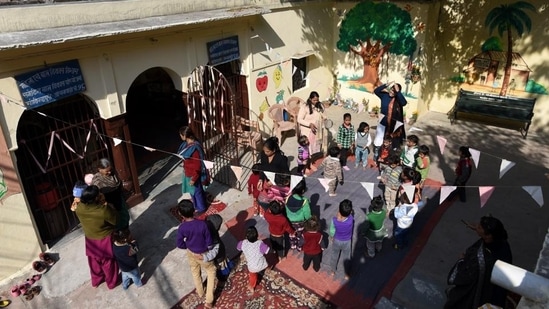Employing more women as early anganwadi educators
This article is authored by Bikkrama Daulet Singh, Siddhant Sachdeva and Sanjana Manaktala.
Meet Radha, an anganwadi worker whose days are a whirlwind of care and community service. From 9 am to 1 pm, she looks after 20-25 toddlers and helps local women with ration collections. In the afternoons, she visits homes to support pregnant and lactating mothers. Despite being called away for tasks like vaccinations and electoral duties, Radha also advocates for menstrual awareness, supports victims of domestic violence, and offers crucial employment advice.

Her role is demanding yet deeply fulfilling, impacting lives well beyond her centre's walls. Working alongside Rama, a helper who assists with cleaning, feeding, and childcare, Radha exemplifies the dedication of frontline workers in anganwadi centres nationwide.
Together, they serve over eight of India’s 13.7 crore children under six years old daily. With nearly 14 lakh centres across the country providing essential services like nutrition, education, health monitoring, immunisation, and counselling, there's a growing need to enhance these efforts with additional educators in each centre, ensuring comprehensive early childhood care and education (ECCE).
Field studies show that anganwadi workers face a heavy workload and must juggle competing priorities. Government evaluations report that they spend 80 to 100 minutes daily maintaining 11 registers for children's attendance, nutrition, height, and weight. Health referrals and immunisations also take longer than prescribed.
Despite challenges, in many states, anganwadi workers deliver joyful, play-based ECCE. In Raigad, Maharashtra, children enjoy locally-provided uniforms, child-friendly furniture, learning toys, and colourful walls with letters and numbers in Marathi and English. In Haryana, visitors are greeted with a cheerful "Good morning, teacher!" as workers proudly show videos of children reciting numeracy rhymes.
However, the nation-wide picture is less clear. Small-scale time-use studies from Tamil Nadu and Madhya Pradesh suggest that anganwadi workers are only able to spend an average of 30 to 90 minutes on preschool education, less than the minimum two hours of daily time prescribed by the National Institute of Public Cooperation and Child Development.
The ministry of women and child development's Aadharshila curriculum and Navchetana framework cater to children from birth to six years, providing structured age-based guidance. These build on the recommendations of the MWCD Taskforce on Early Childhood Care and Education and various state task forces, to separate home visits for 0-3-year-olds from in-centre programmes for 3-6-year-olds. Emphasising small class sizes and dedicated home visit staff enhances the quality of early childhood education. These initiatives recognise the criticality of early interventions, as 85% of brain development occurs before age six.
In Tamil Nadu, adding a female staff member to each centre doubled time spent on ECCE and increased time on health and nutrition activities. Uttar Pradesh and Maharashtra are experimenting with similar staffing enhancements, through partnerships with the department of education and development partners.
The rollout of this additional cadre must consider operational feasibility and the dynamics within existing anganwadi centres to ensure collaboration, task congruity, and efficient division of labour. To minimize resistance, current anganwadi workers could be given the opportunity to transition to the dedicated educator role if they meet basic qualifications such as graduation and relevant years of service.
Additionally, with approximately 900,000 anganwadi centres nationwide where the pupil-teacher ratio exceeds 1:20, there is a pressing need for additional staffing to achieve a reasonable ratio of one educator for every 20 children per centre. This balances between the 1:30 ratio prescribed at primary levels and the global pre-primary average of 1:18.
There is a large pool of eligible candidates, such as waitlisted candidates for government teacher positions or local mothers seeking to enter or re-enter the workforce. By recruiting and training more para-teachers, anganwadi centres can create dignified job opportunities for rural women.
Women seeking employment often face challenges of cultural norms, safe transportation, and limited migration. Working as nursery school teachers within their communities circumvents these issues, making it more feasible for rapid implementation. This not only economically engages women but also serves to build role models, inspiring others to seek employment outside the home.
Financial feasibility is the next question. Currently, anganwadi workers earn an average of ₹9,200 per month, ranging from ₹4,500 in Nagaland to ₹15,000 in Tamil Nadu (at the start of service). Some states, like Punjab and Goa, offer increments based on years of service. Adding an educator to each anganwadi centre would cost ₹1.1-1.2 lakh per person per year, totalling around ₹14,000 crore.
This seems like a sizable investment, but from a job creation standpoint employing local community educators at anganwadi centres offers employment with wages above market rates, non-inflationary impact, and local respect. Community-based educators are also more economically efficient than hiring government primary school teachers, costing nearly three times as much. Exploring public-private partnership models and Corporate Social Responsibility for anganwadi adoption further enhances these opportunities.
Increasing spending on pre-primary education would raise it from 3.3% to 5.6% of India's education expenditure, still below UNESCO's 10% goal but near the lower-middle-income average of 6.5%.
As the 17th Lok Sabha takes charge, the new administration will seek feasible, high-impact initiatives. Transforming early childhood learning is a worthy cause, offering significant short- and long-term benefits to children, women and the nation that far outweigh the costs.
This article is authored by Bikkrama Daulet Singh, operating partner, The Convergence Foundation, Siddhant Sachdeva, co-founder, Rocket Learning and Sanjana Manaktala, policy lead, Rocket Learning, New Delhi.
.





